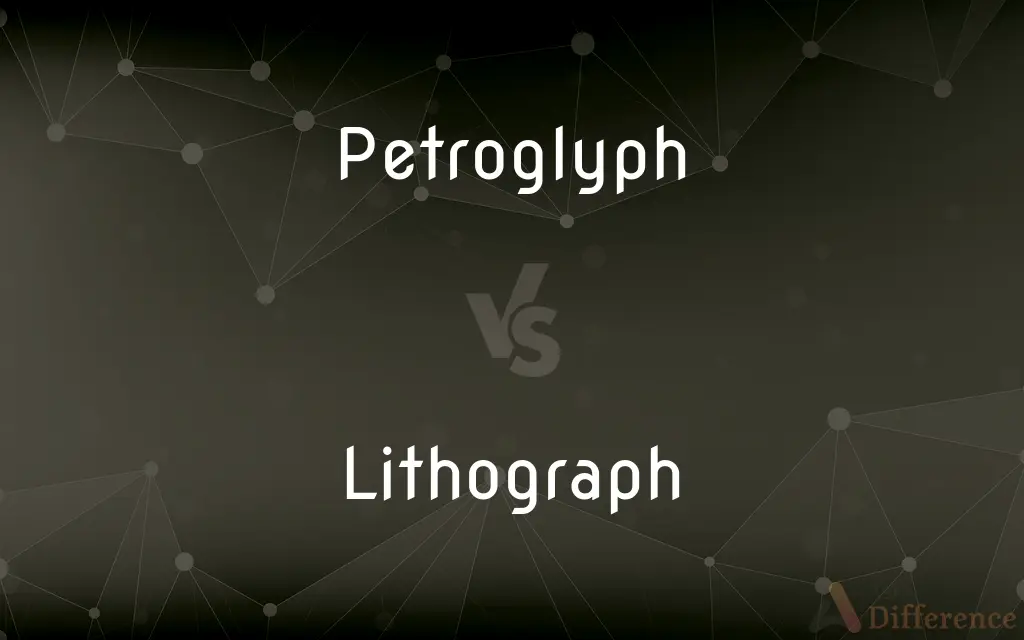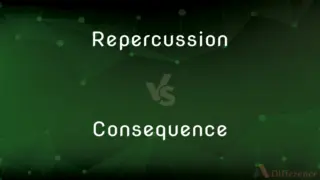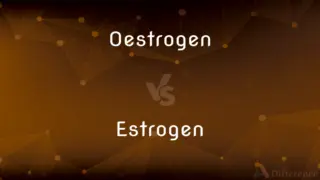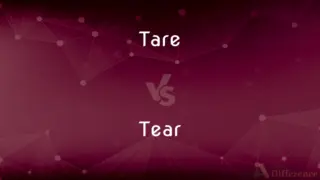Petroglyph vs. Lithograph — What's the Difference?
By Urooj Arif & Fiza Rafique — Updated on April 23, 2024
Petroglyphs are ancient rock carvings created by removing part of a rock surface by incising or carving, while lithographs are printmaking artworks made using a process involving oil and water on a flat stone surface.

Difference Between Petroglyph and Lithograph
Table of Contents
ADVERTISEMENT
Key Differences
Petroglyphs are ancient images and designs carved into rock surfaces using stone tools or other means, reflecting cultural expressions of historical populations. On the other hand, lithographs are a form of printmaking that emerged in 1796, using chemical processes to create images on limestone or metal plates.
The creation of petroglyphs involves direct carving into rock, often in situ in archaeological sites or natural settings, thus they are immovable and directly linked to their original location. Whereas lithographs are created on a portable stone or metal surface, allowing for multiple reproductions and distribution.
Petroglyphs typically depict symbols, figures, or scenes directly related to the cultures that produced them, serving as historical or spiritual documentation. In contrast, lithographs can depict a wide range of subjects, from artistic interpretations to commercial reproductions, reflecting broader uses in modern times.
Due to their method of creation, petroglyphs are exclusively monochrome, relying solely on the natural color of the rock. Conversely, lithographs can involve multiple colors and subtle gradations of tone through complex layering of inks.
The preservation of petroglyphs is subject to environmental conditions and can be threatened by natural erosion and human activities. Lithographs, however, are preserved through controlled environments in galleries or collections and are subject to aging of paper and ink.
ADVERTISEMENT
Comparison Chart
Definition
Carvings on rock surfaces
Printmaking on stone or metal plates
Origin
Ancient, prehistoric times
Invented in 1796
Creation Process
Carved directly into rock
Chemical process on flat surface
Color
Monochrome (natural rock color)
Can be multicolored
Cultural Significance
Historical/spiritual documentation
Artistic and commercial uses
Compare with Definitions
Petroglyph
Carvings or engravings in rock made by ancient civilizations.
The petroglyphs at the site depict animals and hunting scenes.
Lithograph
Commercial printing method evolved from an artistic technique.
Early lithographs were primarily used for creating theatrical posters.
Petroglyph
Ancient symbols carved into stone surfaces outdoors.
The hiking trail leads to a cliff adorned with various petroglyphs.
Lithograph
Collectible prints valued for artistic and historical importance.
Collectors often seek lithographs by renowned artists for their portfolios.
Petroglyph
Cultural artifacts preserved on rocky landscapes.
The petroglyphs serve as a record of the area's ancient inhabitants.
Lithograph
Artistic technique using oil and water on limestone.
Lithography allows for detailed shading and textural effects in prints.
Petroglyph
Prehistoric rock art created by removing part of a rock surface.
Researchers study petroglyphs to understand early human communication.
Lithograph
A print made from a design created on a flat stone surface.
The artist produced a limited series of colorful lithographs.
Petroglyph
Historical rock inscriptions found worldwide.
Petroglyphs have been discovered on every continent except Antarctica.
Lithograph
Process for creating multiple reproductions of an original artwork.
The museum features lithographs from several famous 19th-century artists.
Petroglyph
A petroglyph is an image created by removing part of a rock surface by incising, picking, carving, or abrading, as a form of rock art. Outside North America, scholars often use terms such as "carving", "engraving", or other descriptions of the technique to refer to such images.
Lithograph
A print produced by lithography.
Petroglyph
A rock carving, especially a prehistoric one.
Lithograph
To produce by lithography.
Petroglyph
A carving or incised drawing on rock, especially one made by prehistoric people.
Lithograph
A printed image produced by lithography.
Petroglyph
(archaeology) A rock carving, especially one made in prehistoric times.
Lithograph
To create a copy of an image through lithography.
Lithograph
To trace on stone by the process of lithography so as to transfer the design to paper by printing; as, to lithograph a design; to lithograph a painting. See lithography.
Lithograph
A print made by lithography.
Lithograph
A print produced by lithography
Lithograph
Duplicator that prints by lithography; a flat surface (of stone or metal) is treated to absorb or repel ink in the desired pattern
Lithograph
Make by lithography
Common Curiosities
Can lithographs be multicolored?
Yes, lithographs can be produced in multiple colors through complex layering techniques.
What is the significance of petroglyphs in archaeological studies?
Petroglyphs provide insights into the cultural practices, beliefs, and environments of ancient civilizations.
How do environmental conditions affect petroglyphs and lithographs?
Petroglyphs are exposed to natural weathering and erosion since they are outdoors, which can degrade their visibility and detail over time. Lithographs, being primarily kept indoors and on paper, are susceptible to light exposure, humidity, and chemical degradation of the ink and paper.
What are the key differences in the reproduction capabilities between petroglyphs and lithographs?
Petroglyphs are unique and cannot be reproduced naturally; they exist only as single, original works. Lithographs, however, are designed for reproduction. The original stone or plate can be used to produce multiple, identical copies, allowing artists and publishers to create editions of prints that can be distributed widely.
How old are typical petroglyphs compared to lithographs?
Petroglyphs can be thousands of years old, dating back to prehistoric times, whereas lithographs were first made in the late 18th century.
Are petroglyphs found all over the world?
Yes, petroglyphs have been discovered worldwide, including in North and South America, Europe, Africa, and Asia.
What types of scenes or subjects are commonly depicted in petroglyphs compared to lithographs?
Petroglyphs often depict scenes of daily life, spiritual and religious symbols, and celestial bodies, reflecting the cultural practices and beliefs of their creators. Lithographs vary widely, ranging from detailed landscapes and portraits to abstract designs, depending on the artist's intention and period.
What materials are used to create petroglyphs and lithographs?
Petroglyphs are made by carving into rock surfaces, while lithographs are created using oil, water, and ink on limestone or metal plates.
Can both petroglyphs and lithographs be considered forms of art?
Yes, both can be considered forms of art. Petroglyphs are valued as ancient and cultural art forms, offering insights into the artistic expressions of past civilizations. Lithographs are recognized in both fine art and commercial art, admired for their artistic quality and technique.
How are petroglyphs preserved compared to lithographs?
Petroglyphs are generally preserved in situ with efforts to protect them from vandalism and natural erosion. Conservation strategies might include public education, controlled access, and sometimes chemical treatments. Lithographs are preserved through archival storage, using acid-free materials and controlled environmental conditions to prevent degradation.
Share Your Discovery

Previous Comparison
Cyan vs. Teal
Next Comparison
Repercussion vs. ConsequenceAuthor Spotlight
Written by
Urooj ArifUrooj is a skilled content writer at Ask Difference, known for her exceptional ability to simplify complex topics into engaging and informative content. With a passion for research and a flair for clear, concise writing, she consistently delivers articles that resonate with our diverse audience.
Co-written by
Fiza RafiqueFiza Rafique is a skilled content writer at AskDifference.com, where she meticulously refines and enhances written pieces. Drawing from her vast editorial expertise, Fiza ensures clarity, accuracy, and precision in every article. Passionate about language, she continually seeks to elevate the quality of content for readers worldwide.















































